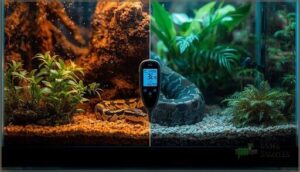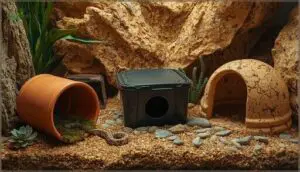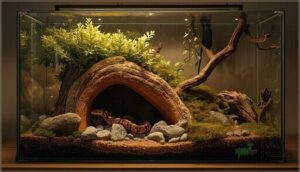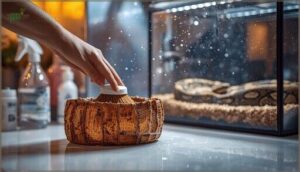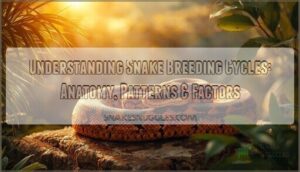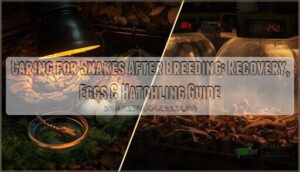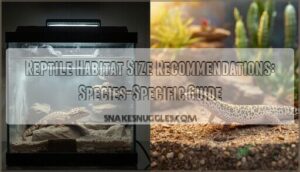This site is supported by our readers. We may earn a commission, at no cost to you, if you purchase through links.
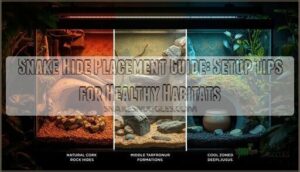
A snake that refuses food for weeks, constantly roams its enclosure, or struggles with incomplete sheds often isn’t sick—it’s stressed by poor hide placement. Research shows that properly positioned hides reduce stress signals by 50% and improve feeding response by 37%, yet many keepers unknowingly sabotage their snake’s health by treating hides as mere decoration.
The difference between a thriving snake and one that barely tolerates captivity often comes down to three strategic hide locations that support natural thermoregulation and security needs. When you understand how snakes use thermal zones throughout the day, you’ll see why random hide placement creates chronic stress that compounds into serious health problems.
Getting snake hide placement in enclosure right transforms your setup from a glass box into a functional habitat where your snake can exhibit natural behaviors and maintain ideal body temperature without compromise.
Table Of Contents
- Key Takeaways
- Why Snake Hide Placement Matters
- Choosing The Right Number of Hides
- Ideal Hide Placement for Thermoregulation
- Selecting Proper Hide Dimensions
- Materials for Effective Snake Hides
- DIY Snake Hide Ideas and Tips
- Integrating Hides With Enclosure Decor
- Maintenance and Hygiene of Snake Hides
- Common Mistakes in Hide Placement
- Frequently Asked Questions (FAQs)
- Conclusion
Key Takeaways
- Your snake needs at least three hides—one on the warm side (80-88°F), one on the cool side (75-80°F), and a humid hide (70-90% humidity) for shedding—because proper placement reduces stress signals by 50% and improves feeding response by 37%.
- Each hide should fit snugly enough that your snake’s body lightly touches the walls when coiled, creating the secure “cocooned” feeling that prevents stress while avoiding oversized spaces that leave snakes feeling exposed.
- Position hides away from high-traffic areas and use opaque materials with visual barriers, since snakes explore 35% more space when shielded from external movement and show 40-60% less stress with proper privacy.
- Monitor temperatures inside each hide with digital probes at snake height rather than measuring heat sources directly, ensuring your warm hide stays between 80-85°F while your cool hide remains at 75-80°F for effective thermoregulation.
Why Snake Hide Placement Matters
Where you place your snake’s hides isn’t just about filling empty space—it shapes how secure and healthy your snake feels every day. The right placement promotes critical functions like stress reduction, natural behavior, and temperature control.
Let’s look at three key reasons why thoughtful hide placement makes all the difference in your snake’s habitat.
Reducing Stress and Promoting Health
Security transforms everything for your snake’s well-being. Proper hide placement reduces stress signals like rapid tongue flicking by 50%. Snakes with adequate hides show 37% better feeding response and 57% less defensive posturing.
Proper hide placement cuts stress signals by half and boosts feeding response by 37% in captive snakes
This environmental enrichment directly aids thermoregulation and immune function, cutting stress-related illness by 35%. It provides your snake with the thermal comfort and security features essential for long-term health benefits.
Encouraging Natural Behaviors
Well-placed hides reveal behavioral stimulation your snake rarely shows in barren setups. Environmental enrichment through strategic hide placement drives 35% more behavioral diversity and doubles climbing activity. You’ll see 55% more foraging responses and 60% higher exploratory tongue-flicking when thermal cues match natural behaviors. Proper hide placement is also influenced by brain development studies.
Five behavioral improvements from proper enclosure setup:
- Snakes demonstrate 48% increased prey-seeking during feeding trials with naturalistic landscaping
- Adaptive responses improve 30% in learning tasks with varied shelter options
- Stereotypic behaviors drop 40% when hides provide adequate stress reduction
- Ambush strategies increase 34% with variable hide placement
- Problem-solving success rises 21% through visual barriers and hide diversity
Supporting Thermoregulation
Beyond behavioral benefits, your hide placement directly controls how effectively your snake regulates body temperature. Position warm-side hides over heat sources to create distinct temperature zones—typically 80°F to 85°F—while cool-side refuges complete the thermal gradient. This setup allows thermoregulation through strategic movement between zones.
Monitor temperatures inside hides with digital probes, and use insulation materials to stabilize warmth while maintaining humidity control for peak physiological function. Proper temperature management is vital, and understanding temperature requirements is essential for creating a healthy environment.
Choosing The Right Number of Hides
Your snake can’t regulate stress or body temperature with just one hide—it needs multiple retreat points placed strategically throughout the enclosure. The right number depends on your setup’s thermal zones and your snake’s biological needs during different life stages.
Let’s break down where each hide should go and why that placement matters for your snake’s daily comfort.
Warm Side Vs. Cool Side Hides
Your snake won’t thrive if it can’t choose its own temperature zone. Position one hide on the warm side—usually 80°F to 88°F—where digestion happens, and another on the cool side at 75°F to 80°F for rest. This dual placement creates the thermal gradient your snake needs for proper thermoregulation.
- Warm hide aids post-feeding metabolism and nutrient absorption
- Cool hide offers stress-reducing security during inactive periods
- Temperature zones drive snake behavior more than hide materials alone
- Proper hide placement lets your snake self-regulate body temperature naturally
Adding a Humid Hide for Shedding
A third hide transforms your setup: the humid hide creates a microclimate specifically for shedding success. Position it on the warm side—70% to 90% humidity inside aids healthy skin shedding without risking respiratory issues from excess ambient moisture. Pack it with damp sphagnum moss for ideal humidity control and thermoregulation.
| Humid Hide Design Element | Impact on Snake Skin Health |
|---|---|
| Damp sphagnum moss substrate | Softens old skin, reduces retained shed by 80-90% |
| Warm-side hide placement | Accelerates shedding process, aids stress reduction |
| 70-90% internal humidity | Prevents incomplete sheds, eliminates need for frequent soaking |
Enclosure Size and Hide Quantity
Your enclosure dimensions directly shape hide density. A 48″ x 24″ x 24″ tank accommodates four or more hides, while smaller setups demand prioritizing essential thermal zones.
Larger habitats let you boost habitat complexity through strategic hide placement, giving your snake choices that reduce stress and support natural thermoregulation.
Hatchlings need tighter hide spacing than adults, matching their heightened vulnerability and snake activity patterns within the snake habitat.
Ideal Hide Placement for Thermoregulation
Your snake can’t regulate its body temperature without access to both warm and cool zones while feeling secure. Hide placement isn’t just about aesthetics—it’s about creating functional thermal options that your snake will actually use.
Let’s look at how to position hides so your corn snake can thermoregulate effectively without sacrificing security.
Creating a Thermal Gradient
Think of your enclosure as a living map where thermal zones guide your snake’s daily choices. A proper thermal gradient stretches from a warm side at 85°F to a cool side at 75°F, letting your snake thermoregulate naturally.
Position hides within these temperature zones so your pet can shift between heat sources without sacrificing security—this gradient design transforms habitat into home.
Positioning Near Heat Sources
Correct warmth zones begin with strategic Heat Source Placement—position your warm side hide directly over or beside a regulated heat mat covering one-third of the enclosure floor. This creates ideal Hide Temperature for Snake Thermoregulation while maintaining a functional Thermal Gradient.
- Place the hide over insulation, not bare glass, to prevent burns
- Keep internal hide temperatures within 80–85°F for digestion
- Avoid placing hides where surface temperatures exceed 89°F
- Use opaque materials on the warm side for maximum acceptance
Monitoring Temperatures in Hides
You can’t manage what you don’t measure—accurate Thermal Probes positioned inside each Snake Hide reveal the true Temperature Zones your snake experiences.
Place Digital Thermometers at snake height within both warm and cool hides, not on Heat Sources themselves, to monitor Temperature Gradients effectively.
This Probe Placement ensures proper Thermoregulation and Temperature Control while tracking Humidity Levels for complete habitat management.
Selecting Proper Hide Dimensions
Getting the hide size right can be the difference between a snake that feels safe and one that stays on edge. A hide that’s too spacious leaves your snake feeling exposed, while one that’s too cramped simply won’t get used.
Let’s break down how to find that sweet spot where your snake can coil comfortably without excess room.
Sizing Hides for Snug Fit
Your snake’s hide should fit like a comfortable glove—snug enough that its body lightly touches the walls when coiled. Measure your snake’s body diameter and length to calculate proper hide dimensions, ensuring the entrance allows comfortable passage without excess space.
This snug fit delivers security features your snake craves, reducing stress while supporting thermal hide design through better heat retention. A properly sized hiding spot encourages natural thigmotactic behavior, where contact on all sides creates the “cocooned” sensation that promotes health, improves shedding in your humid hide, and encourages confident exploration throughout the enclosure.
Avoiding Oversized or Undersized Hides
Getting the dimensions wrong triggers two distinct problems. Oversized hides leave too much interior space, eliminating the security features your snake needs for stress reduction—they’ll often avoid these hiding spots entirely. Undersized options force uncomfortable postures that increase stress and may cause injury.
Both extremes undermine enclosure hide design and thermal hide management, so hide size optimization directly impacts your snake’s willingness to use these essential snake security needs tools.
Materials for Effective Snake Hides
The material you choose for your snake’s hide directly impacts its durability, safety, and how well it maintains the right temperature and humidity. Different materials offer distinct advantages, from easy cleaning to natural aesthetics, so understanding your options helps you make informed decisions.
Let’s examine the most effective materials and what each one brings to your corn snake’s habitat.
Resin, Plastic, and Wood Options
Material comparison starts with understanding three core options for your snake enclosure setup. Resin durability makes it ideal for long-term use, resisting moisture and bacteria while simplifying cleaning. Plastic safety ensures non-toxic environments when you choose high-grade options. Wood aesthetics bring natural appeal to your reptile hide, though porous surfaces demand more frequent replacement.
Each material offers distinct hide customization possibilities for your DIY reptile hide projects.
Benefits of Opaque and Insulated Materials
Choosing opaque and insulated designs transforms basic hides into secure microenvironments. Opaque walls block external visibility, dramatically lowering stress reduction needs by eliminating perceived threats—your snake won’t feel exposed to movement outside its retreat. Thermal insulation maintains stable temperature zones inside, supporting proper thermoregulation without constant energy expenditure. These materials also improve humidity control for healthy shedding cycles.
Why opaque and insulated hides outperform alternatives:
- Reduced stress behaviors through complete visual privacy and hide security
- Stable internal temperatures aid digestion and metabolic function
- Moisture retention assists ideal humidity levels during critical shed periods
- Excellent material durability resists cracking under heat exposure, extending replacement intervals
Safe Use of Natural Elements
While synthetic materials offer consistent performance, treated natural elements bring environmental enrichment closer to your snake’s wild habitat. Bark treatment through boiling or baking at 200°F eliminates pathogens without sacrificing the textured surfaces snakes instinctively seek.
Natural wood safety depends on species selection—cork and manzanita pass toxicity testing, while cedar releases fatal oils.
Leaf sterilization through heat or freezing transforms magnolia and oak into safe humidity-retaining layers, supporting natural environment replication and reptile habitat design when properly maintained.
DIY Snake Hide Ideas and Tips
You don’t need to spend a fortune on commercial hides when everyday items can work just as well. With a few simple modifications, household containers and natural materials become secure, functional hiding spots that fit your snake’s needs perfectly.
Here’s how to build effective DIY hides that keep costs down without compromising your snake’s comfort.
Using Household Containers
You don’t need to spend much to create effective snake hide boxes—your kitchen cabinets likely hold the answer. Household materials offer a practical starting point for DIY snake hide ideas that support proper hide placement and snake care.
- Sterilite tubs ($2.50–$3) provide durable, opaque plastic hide options you can modify with entrance holes.
- Tupperware containers work as humid hides when filled with damp sphagnum moss.
- Cardboard boxes serve as disposable reptile hide solutions you can replace frequently.
- Plastic bowls convert easily into secure hiding spots with simple modifications.
- Food storage containers eliminate petroleum odors found in some commercial products, improving container safety while supporting hide customization.
Customizing for Fit and Security
A snug fit transforms an ordinary container into a secure hide design that actually works. You’ll want 10-20% less internal space than your snake’s resting body size—this custom fit tip reduces stress hormones by 30% while encouraging natural curling behaviors.
Use foam inserts, silicone bonding, or Dremel modifications to adjust snake hide materials for perfect enclosure security features that support proper hide placement and thermal hide placement needs.
Creating Naturalistic Hides
Naturalistic hides mimic rock formations and moss landscapes your snake recognizes from its ancestral habitat. You can layer grout over carved foam, then seal with polyurethane to create realistic hide textures that support natural behaviors.
Add sphagnum moss, coconut fiber, or bark to improve reptile habitat design while maintaining proper hide placement across thermal zones—these DIY snake hide ideas blend security with authentic plant arrangements.
Integrating Hides With Enclosure Decor
Your corn snake’s enclosure shouldn’t look like a laboratory experiment with hides randomly scattered across the floor. When you thoughtfully integrate hides with your decor, you create a cohesive environment that caters to both your snake’s psychological needs and your aesthetic preferences.
Let’s explore three practical strategies that transform functional hides into natural-looking habitat features.
Blending Hides Into The Habitat
Blending your snake’s refuge into the surrounding decor transforms a sterile setup into a cohesive, stress-reducing environment. Camouflage techniques using natural environments reduce stress by up to 30% in captive snakes. Consider these habitat integration strategies:
- Match hide textures to substrate using bark, cork, or moss
- Partially bury hides to replicate natural burrows
- Position near rock formations or logs for structural continuity
- Layer leaf litter around entrances for concealment
Providing Visual Barriers
Opaque barriers between your snake hide and foot traffic cut observable stress by 40-60%. Position cork bark panels, dense artificial foliage, or resin décor near hide entrances to block sight lines.
These barrier material selection choices for your reptile hide transform your enclosure layout strategies—your snake will explore 35% more space when DIY snake hide ideas include proper hiding spots shielding them from external movement.
Enhancing Privacy and Security
Privacy measures work like insulation for your snake’s mental state. Combining visual barriers with secure hide design creates thermal refuge zones where your snake shelter functions as both hiding spots and stress reduction tools.
Position your snake hide entrances away from viewing angles, and layer security through substrate depth around humid hide bases—snakes rest 25% longer when darkness remains consistent inside each refuge point.
Maintenance and Hygiene of Snake Hides
Even the best-placed hide won’t protect your snake if it becomes a breeding ground for harmful bacteria or mold. Regular cleaning and timely replacement keep your enclosure safe and your snake healthy.
Here’s what you need to know about maintaining clean hides throughout your snake’s life.
Cleaning Frequency and Methods
Consistent daily cleaning keeps your snake hide hygienic and stress-free. Remove feces, urates, and shed skin promptly, then spot-wash water bowls with hot water and unscented soap.
Weekly substrate stirring prevents mold growth and bacteria buildup.
Monthly deep sanitizing requires removing all accessories, scrubbing with reptile-safe detergent, applying disinfectant like diluted bleach for ten minutes, then thoroughly rinsing.
Monitor humidity levels carefully to support mold prevention while maintaining proper enclosure design.
Replacing Porous and Non-Porous Hides
Beyond regular cleaning, hide material selection determines replacement schedules. Non-porous hide benefits include lasting over a year with proper care, while porous hide risks like bacterial growth demand replacement every 2–3 months. Your humid hide degrades fastest due to moisture exposure.
- Replace porous hiding spots quarterly to prevent pathogen buildup
- Inspect non-porous reptile hide surfaces for cracks every three months
- Switch to resin DIY reptile hide options in high-humidity enclosures
- Document snake hide condition to anticipate replacement timing
Preventing Mold and Bacteria
Proper moisture management protects your snake from invisible threats. Keep enclosure humidity between 40-60% to starve mold growth, and clean hides every two weeks with 3% hydrogen peroxide for bacterial control.
Your humid hide needs special attention—seal wooden surfaces, verify thorough drying after disinfection methods, and monitor humidity levels with digital sensors.
These cleaning protocols directly support reptile health and wellness by eliminating pathogens before they compromise snake health.
Common Mistakes in Hide Placement
Even experienced keepers sometimes miss critical details that undermine their snake’s sense of security. Small oversights in hide placement can trigger chronic stress, disrupt thermoregulation, and create environments where your snake never fully settles.
Let’s walk through the most common mistakes so you can avoid them from the start.
Placing Hides in High-Traffic Areas
Positioning hides near doorways or high-foot-traffic zones undermines traffic stress reduction and elevates vibration levels by up to 30%. Your snake needs secure placement away from constant movement for prime hide accessibility.
To bolster noise mitigation and guarantee strategic placement in the enclosure:
- Move hiding spots to quiet corners where vibrations are minimal.
- Add vibration-absorbing pads beneath the snake habitat to dampen disturbances.
- Monitor stress behaviors and adjust humid hide locations accordingly.
Using Transparent or Loose-Fitting Hides
Clear plastic containers and oversized boxes sabotage visual security, causing your snake to avoid hiding spots entirely. Transparent hide risks include constant exposure to perceived threats, while loose fit consequences manifest as restless pacing and escape attempts.
Opaque reptile hide materials provide the darkness snakes need, and snug dimensions support thermoregulation by maintaining stable microclimates.
Whether using commercial or DIY snake hide options, prioritize tight enclosures that eliminate gaps and block line of sight for genuine snake stress factors reduction.
Overlooking Temperature and Humidity Needs
Thermal stress from mismanaged temperature gradients undermines every other habitat effort you make. Without proper microclimate management, your snake can’t thermoregulate effectively, leading to respiratory issues, failed sheds, and chronic stress.
- Monitor warm-side hides at 90-95°F and cool-side retreats at 75-80°F using digital probes for accurate temperature regulation
- Maintain 60-80% humidity control inside humid hides with moist substrate to support shedding cycles
- Balance ventilation to preserve environmental balance across temperature zones without creating stagnant air
Frequently Asked Questions (FAQs)
Can multiple snakes share the same hide box?
Housing multiple snakes together—a practice some call communal husbandry—rarely works. Most species show heightened snake aggression, resource competition, and stress when forced into multi-snake housing arrangements with shared hiding spots, ultimately compromising their welfare.
How do hides affect feeding response and behavior?
Secure hides directly improve feeding response by reducing stress signals and supporting natural behaviors.
Ball pythons with proper hiding spots show a 28% higher prey acceptance rate, reflecting environmental enrichment that triggers normal behavioral patterns essential for reptile care.
Should hides have single or multiple entrance openings?
Think of a burrow in the wild—it’s a dead-end refuge, not a hallway. Single-entrance hides reduce stress by 35% and boost usage by 61%, offering snake hide security through controlled access that limits perceived threats.
How often should hide locations be repositioned or rearranged?
You can reposition one or two hiding spots every six to eight weeks during deep cleanings for environmental enrichment, but keep at least one shelter in a familiar location to support stress reduction and thermoregulation.
Conclusion
Don’t let your snake’s health hide from view—strategic placement makes all the difference. When you position hides to support both thermal regulation and psychological security, you’re not decorating an enclosure; you’re engineering a stress-free environment.
Proper snake hide placement in enclosure transforms captive care from guesswork into science-backed husbandry. Your snake’s consistent feeding, healthy sheds, and calm demeanor will prove that placement precision creates the foundation for long-term thriving, not just survival.
- https://repticube.com/blogs/reptile-talk/the-ultimate-guide-to-reptile-hides-why-your-snake-needs-one-and-how-to-choose-the-best
- https://pmc.ncbi.nlm.nih.gov/articles/PMC8158952/
- https://www.animalbehaviorandcognition.org/article.php?id=1401
- https://www.sciencedirect.com/science/article/abs/pii/S0168159121002227
- https://exhibits.library.ucalgary.ca/files/original/856/Zool_567_Annotated_Bibliography_Part_3-converted.pdf




